
The Bismarck Tower (German : Bismarckturm) on the 497-metre-high Peterskopf in the Haardt mountains on the eastern edge of the Palatine Forest stands within an exclave of the municipality of Kallstadt in the German state of Rhineland-Palatinate.

The Bismarck Tower (German : Bismarckturm) on the 497-metre-high Peterskopf in the Haardt mountains on the eastern edge of the Palatine Forest stands within an exclave of the municipality of Kallstadt in the German state of Rhineland-Palatinate.
Planning for the monument dedicated to Reich chancellor, Otto von Bismarck, began in 1896 by the Drachenfels Club [1] and it was erected in 1901 - 1903 under the direction of architect, Friedrich Kunst, from Karlsruhe.
In 1925 a concrete ceiling collapsed during a school visit to the tower. In 1928 the relief, which had been destroyed by the French, was replaced. During the Second World War two bombs hit the tower.
Its first restoration was carried out in 1949 by the Drachenfels Club, a local monument conservation society. In 1973/74 further renovation measures were implemented; this included accommodation for the tower keeper. The tower has been protected as a listed monument since 1986.
The tower is made from bunter sandstone which was quarried in the vicinity. It has a base area of 16.7 x 14 m² and is divided into three sections.
The lower section may be climbed on 15 external steps, from which staircases lead left and right to the lower viewing platform. The second viewing platform follows after a further 20 steps, also external to the tower. An internal staircase then leads to the 30-metre-high third viewing platform. From here, there are extensive views, particularly over the Upper Rhine Plain over 400 metres below.
The Peterskopf and its Bismarck tower is the destination of the annual Bad Dürkheim Hill Run (Bad Dürkheimer Berglauf) which takes place in October. The route is 8,700 metres long and the total climb is 510 metres, making it the longest and steepest element of the Palatine Hill Running Cup ((Pfälzer Berglaufpokal).

Bad Dürkheim is a spa town in the Rhine-Neckar urban agglomeration, and is the seat of the Bad Dürkheim district in Rhineland-Palatinate, Germany.

The Palatinate Forest, sometimes also called the Palatine Forest, is a low-mountain region in southwestern Germany, located in the Palatinate in the state of Rhineland-Palatinate. The forest is a designated nature park covering 1,771 km2 and its highest elevation is the Kalmit.

Drachenfels Castle is a ruined hill castle near the village of Busenberg in the state of Rhineland-Palatinate. It lies within the German half of the Wasgau region, the southern part of the Palatinate Forest.

Battenberg Castle is a castle ruin near Battenberg in the county of Bad Dürkheim in the state of Rhineland-Palatinate, Germany.
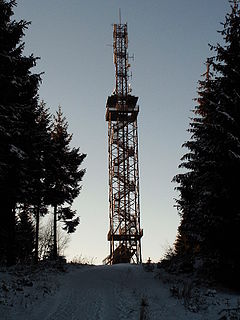
The Carlshaushöhe is a mountain, 626.3 m, in the Harz in the German state of Saxony-Anhalt.

The Isenach is a left tributary of the Rhine in the northeastern Palatine region of Rhineland-Palatinate. It is nearly 36 kilometres (22 mi) long.
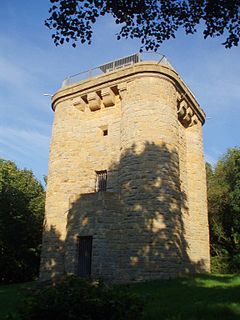
The Bismarck Tower on the 268-metre (879 ft) high Stahlsberg above Opperode in Germany is a monument to the former German chancellor, Bismarck. The tower can be used as an observation tower. It was built in 1914/15.
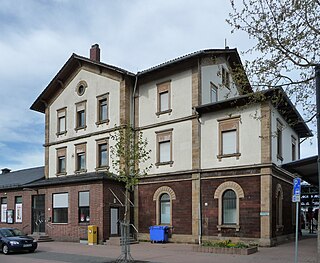
Grünstadt station is a railway junction where the Palatine Northern Railway connects with the Eis Valley Railway and the disused tracks of the Leiningen Valley Railway and the Worms–Grünstadt railway. It is one of three stations in the urban area of Grünstadt in the German state of Rhineland-Palatinate. The station’s entrance building of 1873 as well as parts of the premises are protected as monuments. It is classified by Deutsche Bahn as a category 4 station.
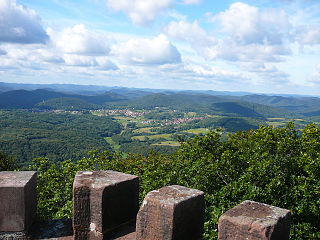
The Wasgau is a Franco-German hill range in the German state of Rhineland-Palatinate and the French departments of Bas-Rhin and Moselle. It is formed from the southern part of the Palatine Forest and the northern part of the Vosges mountains, and extends from the River Queich in the north over the French border to the Col de Saverne in the south.

The Drachenfels is a hill in the northern part of the Palatine Forest in the German state of Rhineland-Palatinate) on the forest estate of the county town of Bad Dürkheim. At 570.8 m above sea level (NHN), it is the highest point of the Palatine Forest north of the Hochspeyerbach - Speyerbach line. The Drachenfels area has been designated as a nature reserve.

The Luitpold Tower was erected in 1909 on the summit of one of the highest hills in the Palatine Forest, the 610-metre-high Weißenberg as an observation tower. It is made of bunter sandstone.

The Peterskopf, near the Palatine county town of Bad Dürkheim in the German state of Rhineland-Palatinate, is a 487-metre-high hill in the Haardt mountains. On its summit is the Bismarck tower.
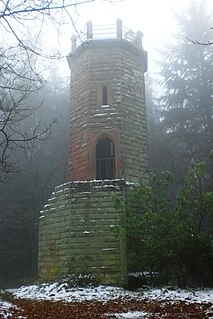
The Schänzel Tower is a 13-metre-high viewing tower on the Steigerkopf near Edenkoben in the county of Südliche Weinstraße in the German state of Rhineland-Palatinate. It was built in 1874 and is the highest-located tower in the mountain range of the Palatinate Forest.
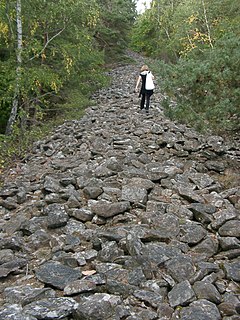
The Heidenmauer near the Palatine county town of Bad Dürkheim in the German state of Rhineland-Palatinate is a circular rampart or ringwork, two and a half kilometres long, which was built by the Celts around 500 B. C. as a type of Murus Gallicus but was pulled down again not long afterwards. The wooden elements of the wall have disappeared over the course of time by rotting away, but the stones have survived.

The Teufelsstein in the Haardt mountains, near the Palatine county town of Bad Dürkheim in the German state of Rhineland-Palatinate, is a hill 317 m above sea level (NN). On its domed summit is a monolith of the same name. Traces of human activity on the rock indicate that it acted as a cult object in former times.

The Kriemhildenstuhl, more rarely Krimhildenstuhl, in the forests around the Palatine county town of Bad Dürkheim in the German state of Rhineland-Palatinate, is an old Roman quarry, which was worked by the 22nd Legion of the Roman Army, who were stationed in Mogontiacum (Mainz) around 200 A. D.
The Drachenfels Club is a society for the preservation and care of monuments in the vicinity of the German town of Bad Dürkheim. It owns numerous natural monuments and listed buildings, some of which it has been given and others which it has established itself.

The Giant Cask or Giant Barrel, is a tourist attraction in the Palatine spa and district town of Bad Dürkheim in the state of Rhineland-Palatinate. The wine barrel has a diameter of 13.5 metres, a volume of about 1,700,000 litres or 1,700 m³ and is thus the largest cask in the world. However, it is not used for the storage of wine, but houses a restaurant.
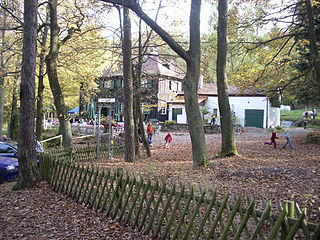
The Lindemannsruhe is an area of upland in the parish of Freinsheim in the German county of Bad Dürkheim. It lies at a height of 465 metres above sea level (NN) in the foothills of the Palatinate Forest, below the Peterskopf and was named after a former senior forester, Lindemann. It is a popular recreation area for walkers, hikers and cyclists.